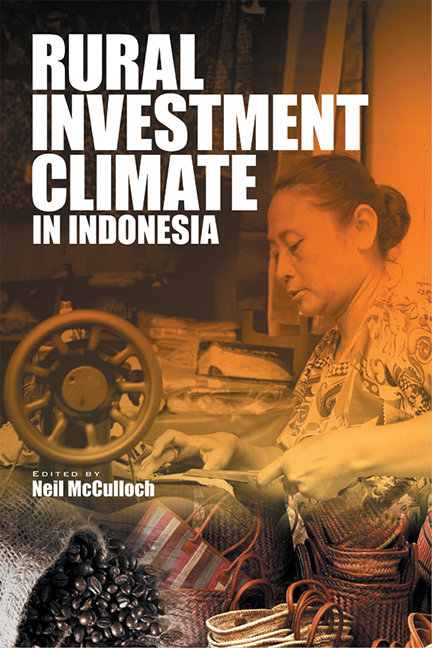Book contents
- Frontmatter
- Contents
- List of Tables, Figures, and Boxes
- Abbreviations and Acronyms
- The Contributors
- 1 Introduction
- 2 Agricultural Demand Linkages and Growth Multipliers in Rural Indonesia
- 3 Trends and Constraints Associated with Labour Faced by Non-Farm Enterprises
- 4 The Constraints in Accessing Credit Faced by Rural Non-Farm Enterprises
- 5 The Constraints Associated with Infrastructure Faced by Non-Farm Enterprises at the Kabupaten Level
- 6 Technology/Knowledge Transfer and Diffusion in Indonesian Non-Farm Enterprises
- 7 Marketing and Competition in the New Indonesia
- 8 Local Tax Effects on the Business Climate
- 9 Leadership and Voice in Local Governance
- 10 Insecurity and Business Development in Rural Indonesia
- Index
8 - Local Tax Effects on the Business Climate
Published online by Cambridge University Press: 21 October 2015
- Frontmatter
- Contents
- List of Tables, Figures, and Boxes
- Abbreviations and Acronyms
- The Contributors
- 1 Introduction
- 2 Agricultural Demand Linkages and Growth Multipliers in Rural Indonesia
- 3 Trends and Constraints Associated with Labour Faced by Non-Farm Enterprises
- 4 The Constraints in Accessing Credit Faced by Rural Non-Farm Enterprises
- 5 The Constraints Associated with Infrastructure Faced by Non-Farm Enterprises at the Kabupaten Level
- 6 Technology/Knowledge Transfer and Diffusion in Indonesian Non-Farm Enterprises
- 7 Marketing and Competition in the New Indonesia
- 8 Local Tax Effects on the Business Climate
- 9 Leadership and Voice in Local Governance
- 10 Insecurity and Business Development in Rural Indonesia
- Index
Summary
Introduction
This chapter reviews the state of our knowledge about local taxation in Indonesia and analyses the effects of local taxation on the business climate. We employ a simple cost-benefit framework to organize the discussion of such effects. Costs include the revenue burdens and compliance costs associated with local taxation that are borne by private businesses. Benefits comprise the public services delivered to businesses that are funded from local tax payments. The chapter also summarizes the state of the art regarding the effectiveness and efficiency of local tax administration, as well as corruption attendant to local taxation. We focus on the influence of local administrative ineffectiveness and inefficiency and corruption on tax burdens, compliance costs, and service delivery.
We examine local jurisdictions as a whole in this chaper; that is, we do not differentiate between kabupaten and kota. The distinction between kabupaten and kota has less meaning than one might imagine in the current context. The administrative categories of kabupaten and kota are not good proxies for rural and urban, for example. About one-third of the total kabupaten population is urban and the urbanization rate ranges from zero to 90 per cent across all kabupaten. While 95 per cent of total kota population is urban, the rate of urbanization varies from 55 per cent to 100 per cent across kota. Moreover, we cannot organize all relevant cost and benefit data according to a kabupaten and kota classification scheme.
We adopt a loose and implicit definition of the business climate. We simply assume that tax burdens and compliance costs have a negative impact on the business climate and that public service delivery has a (potentially) positive effect on the business climate.
The chapter proceeds as follows. First, we provide some rather extensive background material on local taxation. Here we examine local government own-source revenue and (central) property tax revenue, pre-and post-decentralization, as well as review certain issues related to newly created local taxes and charges during the post-decentralization period. Second, we outline our cost-benefit analytical framework in more detail. Third, we review the available evidence regarding the costs and benefits of local taxation and the impact of administrative ineffectiveness and inefficiency and corruption on such costs and benefits.
- Type
- Chapter
- Information
- Rural Investment Climate in Indonesia , pp. 224 - 245Publisher: ISEAS–Yusof Ishak InstitutePrint publication year: 2009

